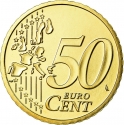You are about to finish your registration. Please check your mailbox (including spam folder). There should be a letter with a confirmation link. Check setting to make sure that your e-mail address is correct.
Send letter againDescription
On 7 June 2005, the European Council decided that the common side of the €0.10 to €2 coins should be brought up to date to reflect the enlargement of the EU in 2004. The €0.01, €0.02 and €0.05 coins show Europe in relation to the rest of the world, therefore they remained unchanged. In 2007, the new design was introduced. The design still retains all elements of the original designs but the map of the fifteen states is replaced by one showing the whole of Europe as a continent, without borders, to stress unity.
Obverse

|
The Vienna Secession building, illustrating the birth of art nouveau in Austria and symbolising the birth of a new age, a bridge to a new monetary era, is encircled by the facial value, heraldic hatchings representing the Austrian flag and the twelve stars of Europe. 50 EURO CENT |
|---|---|
Reverse

|
A geographical map of Western Europe spans the outer ring and inner core on the left side of the coin. 50 |
| Edge |
50 Euro Cent
2nd map
KM# 3141 Schön# 345
Swap now (1 offer)
Characteristics
| Material | Nordic Gold |
| Weight | 7.8 g |
| Diameter | 24.25 mm |
| Thickness | 2.38 mm |
| Shape |
|
| Alignment | Medal |
| Mint |
Austrian Mint
|



